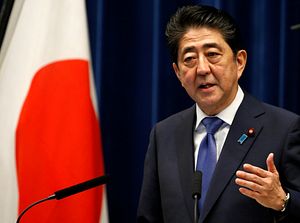On Monday, Japanese Prime Minister Shinzo Abe announced he would dissolve the House of Representatives of the Japanese Parliament (the Diet) on Thursday. The dissolution of the Diet will mean a snap election will take place by the end of October. Abe said he will “seek the mandate of the people” to deal with a number of growing crises.
Abe, a member of the Liberal Democratic Party (LDP) staged a political comeback in 2012 when he was reelected prime minister by the Diet after resigning for health reasons in 2007. Since 2012, Abe has focused primarily on economics and defense. Both are vitally important for Japan, as its economy has largely stalled since the Asian Financial Crisis in 1997, and as Japan contends with North Korean provocations and Chinese claims over the Diaoyu/Senkaku Islands.
Abe Since 2012
Dubbed “Abenomics,” the prime minister’s economic strategy has a three-pronged approach. First, in 2013 the Abe government passed a fiscal stimulus bill, totaling 20.2 trillion yen ($210 billion), of which about half was direct government spending. In 2016, the government again passed a stimulus, this time of 28.1 trillion yen ($276 billion). Between the two packages, the Abe government passed smaller stimuli in the hopes of increasing demand. Second, the Bank of Japan began an unprecedented level of quantitative easing: while the U.S. Federal Reserve holds assets worth less than 25 percent of GDP, those held by the BOJ exceed 70 percent of Japan’s GDP. Attached to quantitative easing, the BOJ introduced negative interest rates in January of 2016. Third, Abe has introduced key structural reforms, such as cutting corporate taxes and liberalizing the labor market. These reforms have focused heavily on getting more Japanese, primarily women and older citizens, into the rapidly aging workforce. The policy has mixed reviews, with detractors claiming that it fails to address the underlying problems and with supporters claiming that, given the difficult economic position in which it started, the programs should be sustained.
On the defense side, Abe has taken a harder line on both North Korea and China and has stepped up Japanese efforts to build regional partnerships. Both China and Japan lay claim to the Diaoyu/Senkaku Islands in the East China Sea, which are surrounded by rich fisheries and lay atop an estimated 100-160 billion barrels of oil. China has supported its claim to the Islands, which are governed by Japan, by sending ships to fish and harass Japanese workers. The dispute has led Abe to bring up the specter of the first World War, where close trading relations failed to prevent Britain and Germany from going to war.
On the Korean front, Japan has always been concerned about destabilization on the peninsula. This concern has been one of the primary reasons Japan has always been such a vocal supporter of U.S. engagement in East Asia. Recent tensions have only highlighted Japan’s reliance on America. In an attempt to reduce this reliance due to the belief that the United States may become an increasingly unreliable ally, Abe has tried to rewrite the Japanese Constitution. The constitution currently forbids Japan from waging war, and this has led to laws that heavily limit what actions the Japanese military (called the Self-Defense Forces) can take. Abe’s main reforms would allow the SDF to act like a normal military. This has met heavy resistance from opposition politicians and activists. Finally, stemming from China’s rise and the United States’ new unreliability, the Abe government has reached out to regional powers to establish new security relationships. These primarily include improving defense research and technology transfers as well as information sharing with India and enhancing military coordination and access with Australia.
With the economy on shaky ground, and a string of scandals plaguing Abe’s cabinet, weakened Abe’s overall support. Yet his favorability numbers have fluctuated. By the end of 2016, Abe polled at his highest approval rating since 2013 at 64 percent, which then dropped to less than 30 percent this past summer, and have rebounded to over 50 percent now. The weakness of opposition parties, as well as the number of foreign crises threatening Japan, have worked to bolster Abe’s numbers.
The Next Elections
The snap elections will be held by the end of October. With his poll numbers reaching above 50 percent and unlikely to go much higher, Abe is capitalizing on Japanese public’s rally-around-the-flag in the face of North Korean provocations, with Abe claiming: “I’ll demonstrate strong leadership and stand at the forefront to face a national crisis.” He hopes to secure a mandate to bolster his bargaining position vis-a-vis North Korea and the continuation of Abenomics.
More than simply securing his position, Abe is taking advantage of a poorly organized opposition. The main opposition party, the Democratic Party, fluctuates between being a slightly less conservative LDP and a true progressive organization. Polls show that popular support for the Democratic Party stands at around 5 percent. Such an ideologically loose and popularly disdained opposition means that Abe will ride out economic stagnation and political scandals to further the LDP’s hold on power in the snap elections. Indeed, that is exactly why he is calling them.
Zachary Torrey is an MSc Candidate in Conflict Studies at the London School of Economics, focusing on politics and political economy of the Asia Pacific.

































